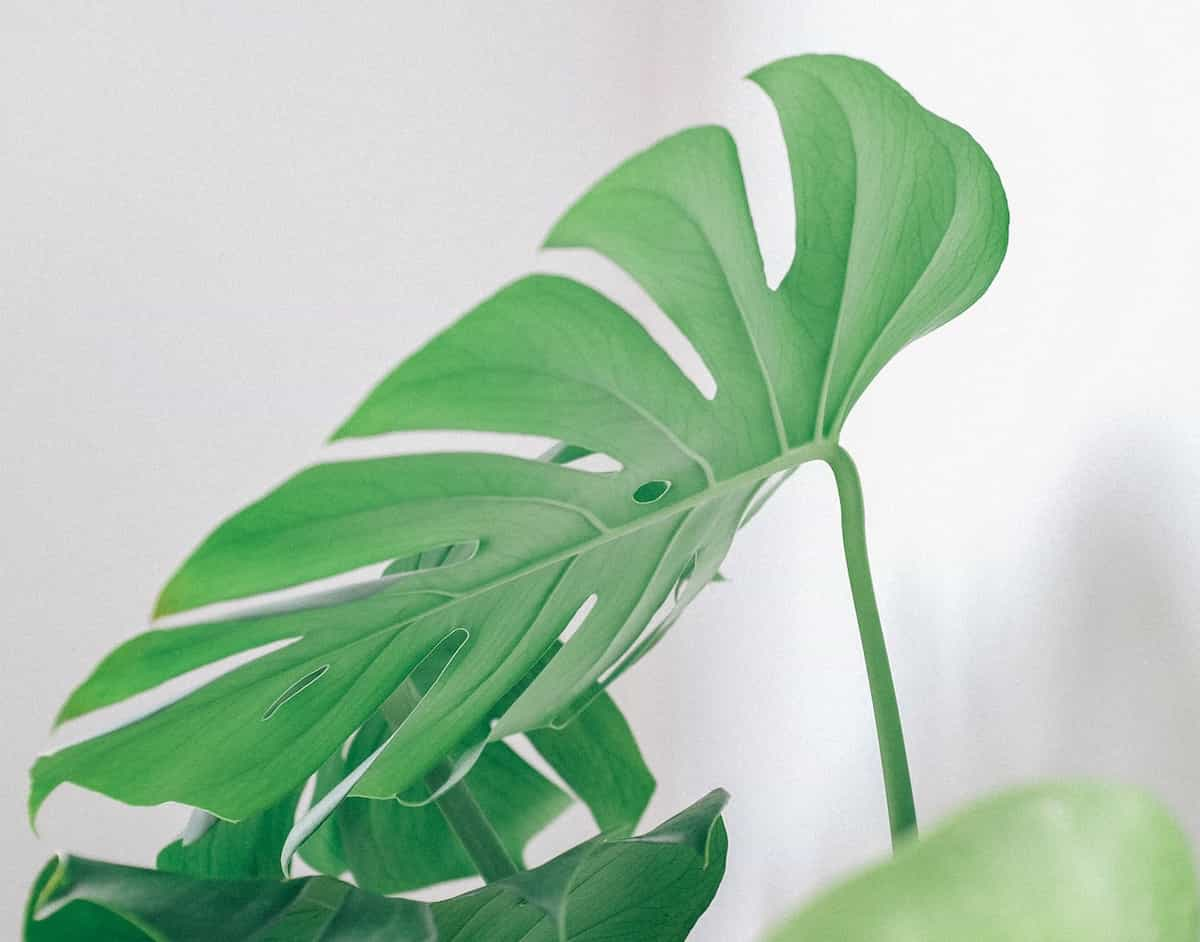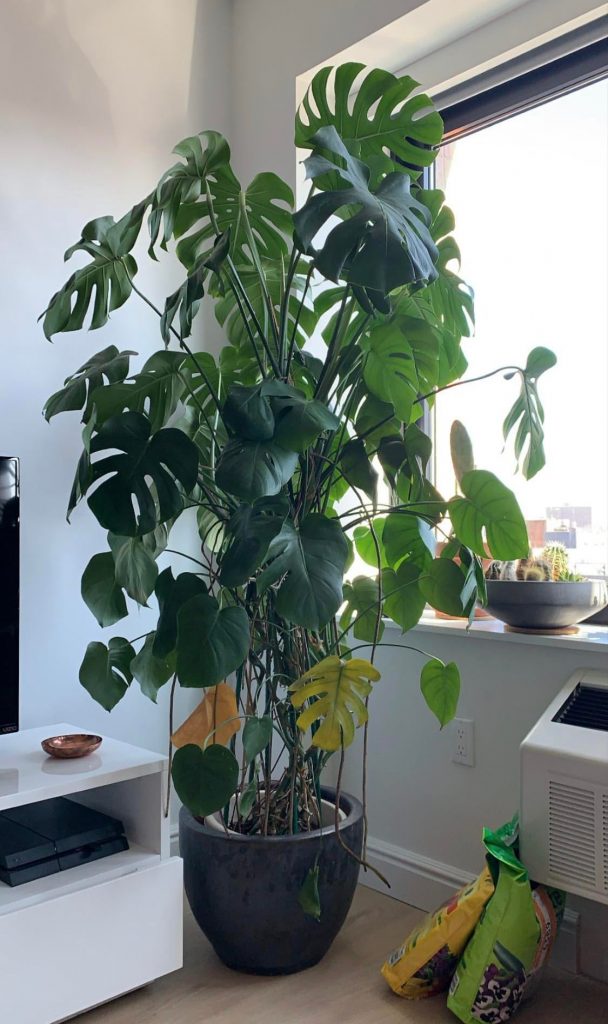While you may know the Monstera for its unique leaves, they’re actually tropical plants that are native to Central and South America, where they grow under the canopy in rainforests. Because the foliage needs sunlight to produce energy for the plant, they grow upwards from the forest floor to reach the light above the canopy.
This is why it’s completely normal to have a climbing Monstera, as their natural state is to climb towards the light. And with a bit of care, you can also train your Monstera to climb at home if you provide it with the growing conditions it needs to thrive.
Let’s see how you can do get it to do just that.

Table of Contents
How do I get my Monstera to climb?
Healthy Monstera plants are natural climbers, but it is up to you to provide them with the conditions they need to flourish. Climbing Monstera care begins with providing the plant with the growing conditions it needs to thrive.
1. Adequate water
Your Monstera plant needs adequate water to grow healthy foliage and aerial roots so that it can climb your totem or Monstera moss pole.
When it comes to the question of how often to water your Monstera, you should water your plant thoroughly when the top two to three inches of the soil feels dry to the touch. Allow the soil to dry before watering it again, but do not allow it to dry out completely.

The soil in the bottom half of the pot should feel moist to the touch, but not soggy. Monsteras are susceptible to root rot which can occur if their roots remain wet.
They are also sensitive to soil that dries out too much. This may cause delayed growth, small leaves, and weak stems.
2. Bright, indirect light
To meet your Monstera’s light requirements, place your Monstera plant in a location that receives bright, indirect light for 5 to 8 hours a day. While it will grow with less light, the growth rate will slow, and it may not climb as well or as quickly as you would prefer.
An eastern window where your Monstera receives several hours of soft morning light is ideal. A Monstera in an eastern window can tolerate some direct sunlight.
If your climbing Monstera plant is near a western or southern window it needs to either be moved several feet from the window or be provided with sheer curtains to filter the light.
Monstera plants cannot tolerate direct sun from western and southern windows. In particular, Monsteras that receive too much light may wilt, develop discolored or brown leaves, and have dried soil.
3. Regular, sufficient fertilizer
Monsteras are not heavy feeders, but they do benefit from regular feedings with a balanced fertilizer designed for houseplants.
Fertilize your Monstera plants once or twice a month from spring until fall when they are actively growing. Withhold fertilizer from fall through the winter, as your Monstera plant needs a rest after growing all summer, and resume your fertilization routine in the spring when you observe signs of new growth.
Monstera plants that do not receive the nutrients they need will show signs of slowed growth, small leaves, and fail to climb as expected. In fact, if your Monstera leaves don’t split (let alone climb), this could be the reason.
Best fertilizer for Monsteras
Jack’s Classic 20-20-20 All Purpose Fertilizer
A great fertilizer with the perfect balance for your Monstera. Simply dissolve in water and feed your plant to watch it thrive.
4. Appropriate humidity levels
Like other tropical plants, Monstera plants like humid air. You can accomplish this by using a humidifier near your plants, grouping houseplants together, or by using pebble trays filled with water under your plants.
Avoid growing your Monstera plant in areas that are prone to either cold or hot drafts. Be cautious of heating and air conditioning vents that may blast your plants with hot or chilly air throughout the day.
If you have your plant growing in dry conditions, your Monstera’s leaves may curl or dry out, show signs of slowed growth, and have aerial roots that dry or shrivel. You Monstera needs healthy aerial roots to cling to your plant support to climb the pole, so if you notice your Monstera drooping, it’s time for some investigation why.
Does Monstera like climbing?
Monstera plants are natural climbers and will happily climb a support if you provide them with one. Otherwise, your Monstera plant may sprawl or vine over the sides of the pot. While some Monstera plants make delightful trailing plants, most plant lovers enjoy seeing them climb.
Monsteras like to climb, but they do need something to cling to. Aerial roots need a rough surface, like bark, moss, or jute to secure the vines to the plant support.
Initially, your Monstera plant vines may need help to get them started in their climb. Once they are established and begin to climb, most Monsteras reach for the sky with no help from you.
Should I let my Monstera climb?
You should let your Monstera climb as not only is it natural for them, but it looks great too! Most Monstera lovers prefer to provide a structure, such as a moss-covered pole or totem for them to climb.
To help them with climbing, Monstera plants produce vines covered with aerial roots. Aerial roots on Monsteras can absorb moisture and nutrients from the air, but that is not their only purpose. They also cling to the rough surfaces of large trees in the rainforest to help the Monstera vine climb towards the canopy – which is exactly what a moss pole can do for your plant in your house.

That said, not all Monstera climb. Some varieties, like Monstera adansonii, create an outstanding display in hanging pots or baskets. They can also be placed on top of bookshelves, filing cabinets, or even the top of the refrigerator and allowed to cascade over the sides.
Ultimately, whether you let your Monstera climb or choose to grow it grow so the cascading vines fall freely is a matter of personal preference.
For a bit of variety, train some of your Monstera plants to climb and let others show off their striking foliage by trailing from pots or baskets. Or cluster several Monstera plants together and erect a trellis (or latticework) against the wall to create a Monstera climbing wall.
What Monstera climbs?
As climbing or vining tropical plants, all Monsteras have the ability to climb, but they may need a little help from you to get them started. Providing them with the growing conditions they need is the first step to keeping them healthy and encouraging them to climb.
A pole or trellis covered with a rough surface such as moss, jute, or bark will give your climbing Monstera something to cling to.
Can you make Monstera grow upwards?
Monstera will grow upwards when provided with the right growing conditions. Notably, Monsteras have developed the ability to climb rough surfaces to grow above the canopy in the rainforest and so replicating its natural habitat in your home as much as possible will see it climb there too.
The reason Monsteras climb naturally is because it’s necessary to prevent the plant from spending a lifetime in the lowlight conditions on the forest floor.

Although they do not grow in full, direct sun, they do need bright light to perform photosynthesis and make the food the plant needs to thrive. The aerial roots that cling to rough surfaces and the plant’s ability to climb are adaptations to ensure they receive enough light to thrive in the wild.
So when it comes to your houseplant, providing supports or trellises for your Monsteras to climb takes advantage of this amazing plants’ natural inclination to grow upwards.
How do I attach a Monstera to a trellis?
Although Monstera plants are natural climbers and readily attach their aerial roots to rough surfaces to grow upwards, they sometimes need a little help from you to get them started. If you have been wondering how to train a Monstera to climb this is the information you’ve been looking for.
- Tie the thickest stems to the trellis with soft plant ties. You can also use a cut section of pantyhose as a plant tie. The tie should be tight enough to hold the vine along the trellis, but loose enough to allow the vine to grow. Green ties or ties that blend into the color of the moss or bark are less noticeable.
- Secure the stems to the trellis in several locations spacing them 4 to 8 inches apart, depending on the size and weight of the vine. If you find the ties unseemly, you can remove them later when the aerial roots take over the job of providing the vines with an anchor to the support or trellis.
- Trim horizontal vines coming off the main vines. Removing them causes the plant to produce more vertical stems and encourages the main stem to climb up the trellis or plant support.
What’s a Monstera climbing wall?
A Monstera climbing wall is essentially a standard wall that a Monstera climbs up instead of using a moss pole or trellis. It involves your plant attaching itself to the wall as it grows upwards, with its vines then spreading upwards and along the climbing wall.
You can see an example of a Monstera climbing wall on Reddit where one person had great success at getting their Monstera Adansonii to climb a wall. And as you can see there, it can look really spectacular to see that in a room.
It’s also not that hard to train a climbing Monstera to go up a wall. The video below shows you just what to do if you’re interested in encouraging your plant to do the same.
How do I make my mini Monstera climb?
Like true Monsteras, the Mini Monstera climbs naturally. You can help it out by providing it with the right growing conditions and tying the vines to a trellis or plant support to get them started.
Mini Monsteras are delightful plants that look like small Monsteras. But this is a case of calling a plant by another’s name based on its appearance.

That is, Mini Monsteras aren’t really Monsteras at all, but they are part of the same family. Mini Monsteras (Rhaphidophora Tetrasperma) are native to Southern Thailand and Malaysia. True Monsteras are native to Central and South America.
However, like Monsteras, these tropical plants produce aerial roots that help them cling to a totem or trellis. It produces 6-inch split lobed leaves and looks like a miniature version of Monstera Deliciosa. It can grow to 10 to 12 feet high in the wild but typically grows to 2 to 4 feet high when grown as a houseplant.
Mini Monsteras require the same basic care as their larger cousins but can tolerate cooler temperatures. They are fine with temperatures as low as 55 degrees, while other Monstera plants suffer if the temperature drops below 60.
What can I use for a mini trellis?
You can purchase small trellises suitable for houseplants at your local improvement center or plant outlet, but you can also make your own. Try these simple methods for making your own trellises for your Mini Monstera plants.
Tomato cages
Tomato cages come in several sizes and colors and are ideal for a trellis in a houseplant. To use a tomato cage as a trellis, follow these steps:
- Bend the ends of the stakes on the cage so they meet in the middle. Secure them with wire or twine.
- Place the tomato cage over your plant so that the circular rings at the top of the cage rest on the soil and the pointed end points upwards.
- Secure the cage into the soil of your plant pot with sections of bamboo stakes or with landscape pins.
- Train your Mini Monstera to climb the cage.
Bamboo stakes
Bamboo stakes make an excellent trellis for your Mini Monstera plant.
To make the trellis, do the following:
- Find three bamboo stakes.
- Tie the ends of the stakes together with garden twine.
- Insert the ends of the stakes in the plant pot so it makes a simple teepee.
- Train your Mini Monstera to climb the trellis.
Plastic fencing
Plastic fencing is an excellent choice for making a trellis for tropic climbing plants. You can find plastic fencing at your local hardware store or gardening center.
To make a trellis from these, you can do the following:
- Cut a section of the plastic fencing that is wide enough to wrap around the pot when it is rolled into a cylinder.
- Place the cylinder in the pot
- Anchor it in place with sections of bamboo stakes, dowels, or sticks.
Moss covered stake
You don’t need to buy a moss-covered totem or stake for your Monstera plants. You can make them yourself from scrap wood and some sphagnum moss.
Simply select a slab of wood or a pole the appropriate size and height for your plant. Cover the wood with sphagnum moss and secure it in place by wrapping it with fishing line or twine.
Jute covered poles or slabs
You can make a jute-covered pole or slab, too. Begin with a slab of wood or a pole the appropriate size for your Monstera plant.
Wrap the jute around the wood so that it is covered with jute. Use dabs of hot glue to secure the jute to the wood and prevent it from unraveling.
When should you give your Monstera plant a pole?
It is easiest to add a moss-covered pole to your Monstera’s pot when you repot your Monstera. This ensures there is plenty of room for the pole and that tender young roots are not injured.

However, that may not always be practical. If your Monstera plant has grown so tall it is beginning to flop or vine, and you aren’t ready to repot it yet, you can stake it at any time. For best results, use a thin stake or a trellis, like those made with plastic fencing or bamboo stakes, that can be inserted without damaging the roots.
A teepee-shaped trellis or obelisk with a wide base of thin stakes gets its support from its design. Weight is distributed out the outer legs (usually resting inside the inner rim of the pot) stabilizing the trellis as the Monstera plant grows.
Tips for erecting a moss pole or totem for your Monstera
Installing a moss pole or Monstera stake for your climbing Monstera plant shouldn’t be difficult, but it does require some consideration and care.
- Choose a pole or totem that is approximately 12 inches taller than your Monstera plant.
- Dig a hole in the center of the pot using care not to disturb the roots of the plant. This may be a challenge if your Monstera is planted in the center of its existing pot. However, placing the stake too close to the outside of the pot poses a risk of tipping or falling over under the weight of your growing Monstera.
- Repot your Monstera plant into a larger pot with the plant’s roots slightly to the side and the pole in the center if you have concerns about disturbing or injuring the roots of your potted Monstera plant. You can find out more about the best pot for your Monstera in our article on this.
- Firm the soil down around the stake with your hands to secure it and prevent it from toppling.
How to keep a Monstera’s moss pole moist
Keeping the moss on the pole moist, but not soggy is important as this keeps the aerial roots from drying out. You can accomplish this is in two ways.
- Increase the humidity levels around your plants by using a humidifier, grouping several plants together, or with pebble trays filled with water. This will raise the humidity near the plants and help to keep the moss moist.
- Spray or water the moss pole directly with water. While most Monstera lovers prefer to mist the moss with a spray bottle, you can pour water on the pole, too. Use a filled water bottle and squirt or pour water on the top of the pole and let it run down the pole.
Final thoughts on how to train a Monstera to climb
With the proper care and a little help from you, you can easily train a Monstera to climb. In fact, these plants will often climb a trellis or pole instinctively.
The secret is to provide them with the growing conditions they need to thrive and lend them a hand by training the young vines to cling to the pole.
If you are dreaming of a dramatic, climbing Monstera with lush foliage adorned with lacy holes and splits, training it to climb upwards may be the answer to your dreams.

